|
The
|
THE BURGENLAND BUNCH NEWS - No. 233 June 30, 2013, © 2013 by The Burgenland Bunch All rights reserved. Permission to copy excerpts granted if credit is provided. Editor: Thomas Steichen (email: tj.steichen@comcast.net) Our 17th Year. The Burgenland Bunch Newsletter is issued monthly online. It was founded by Gerald Berghold (who retired Summer 2008 and died in August 2008). |
Current Status Of The BB: * Members: 2161 * Surname Entries: 7215 * Query Board Entries: 5162 * Staff Members: 17 |
This newsletter concerns: 1) THE PRESIDENT'S CORNER 2) VISITING THE DIOCESAN ARCHIVES IN EISENSTADT (by Joy Minns) 3) BOOK REPORT: "BORDERLAND," BY ANDREW F BURGHARDT 4) THE WINDMILL OF PODERSDORF AM SEE (by Hannes Graf) 5) FOLLOW-UP TO "MARIA HOFFMANN HOTWAGNER" 6) HISTORICAL BB NEWSLETTER ARTICLES: - PURPOSE OF ETHNIC ORGANIZATIONS LIKE THE BURGENLAND BUNCH (BB) & THE BURGENLANDISCHE GEMEINSCHAFT (BG)? 7) ETHNIC EVENTS 8) BURGENLAND EMIGRANT OBITUARIES (courtesy of Bob Strauch) |
1) THE PRESIDENT'S CORNER (by Tom Steichen)  Concerning
this newsletter, after the Bits and Pieces in my President's Corner below, Joy Minns
provides our first full-length article, as she tells us about Visiting the Diocesan Archives in Eisenstadt.
I follow that with a book-report article on Andrew Burghardt's 1962 book, Borderland: A Historical and Geographical
Study of Burgenland, Austria. Next comes a joint article, wherein Hannes Graf first tells is about
the old Windmill of Podersdorf am See and I follow with some information about Modern-Day Windmills.
We then provide a follow-up to an article from two months ago... it shows how interconnected we Burgenländers still are. Concerning
this newsletter, after the Bits and Pieces in my President's Corner below, Joy Minns
provides our first full-length article, as she tells us about Visiting the Diocesan Archives in Eisenstadt.
I follow that with a book-report article on Andrew Burghardt's 1962 book, Borderland: A Historical and Geographical
Study of Burgenland, Austria. Next comes a joint article, wherein Hannes Graf first tells is about
the old Windmill of Podersdorf am See and I follow with some information about Modern-Day Windmills.
We then provide a follow-up to an article from two months ago... it shows how interconnected we Burgenländers still are.The remaining articles are our standard sections: Historical Newsletter Articles, and the Ethnic Events and Emigrant Obituaries sections. But I start with some bits and pieces: Email-Harvesting Spiders and the BB: A concern when one runs a public website is security. Below is an exchange (one of two I had in recent months) where a person was concerned about the security of the information on the BB website. While I consider the BB website to be adequately secured (as you will see if you read below), I ask that you contact me if you have reason to believe otherwise. If necessary, the BB will takes steps to correct any problem that becomes evident. A potential new member wrote (in part):
I replied (in part):
So, if you see the names Burgenland and Heideland associated with Germany, now you know why. If interested, you
can visit its (German-language) website at
http://www.saechsisches-burgenland.de/.
If you go there (the webpage), you will see the page unabashedly advertises Limburger and Liederkranz
cheese (and if you go to their actual store, you'll likely be able to smell the factory!). Now Limburger I've heard
of, but Liederkranz? never! Given the name of the cheese (and the slogan), I had to share... so below is the
description published on the website (I don't know what to think of the "aged 1+ months" note... perhaps they quit aging
it if it gets quickly stinky? lol).
While it was obvious to me that this was indeed, by far, the Grösster (largest) tree in this forest, it wasn't
clear why Hannes called it an American immigrant, so I inquired. Hannes replied by sending two more pictures and an
explanation. He said:
For me, with all my ancestors now departed, there was an added poignancy to the quote (even though it is a bit of a
non sequitur as used above). |
2) VISITING THE DIOCESAN ARCHIVES IN EISENSTADT (by Joy Minns) 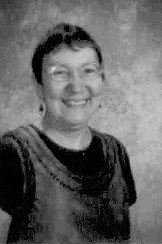 After
spending a year poring over the LDS films for Kethely (Neumarkt im Tauchental) and Bándol (Weiden bei Rechnitz), my “new
finds” have slowed down quite a bit. Every time I look at the films I make a discovery but, as the films cover mainly just
the time period of 1835-1895 (they actually start in 1820 but are spotty until 1835), they didn’t help me dig into the
deeper past of my relatives. I decided to visit the Diocesan Archives in Eisenstadt during a trip to Vienna in late April.
Although the Burgenland Bunch “Helpful Hints” warned that you must either call or send a letter to set up an appointment I
tried email with the subject line “Matrikeneinsichtsbewilligung” (permission to view church records). As warned, I
received no reply. As painful as it was to my frugal spirit, I made a phone call to Eisenstadt. Be warned: English is
useless here! When the connection is made you hear church bells and a message in German. Luckily I speak German so I knew
which button to push and was connected to the secretary. I explained that I wished to set up an appointment to view the
records and that I was especially interested in learning what I could about the Osztovics, Milosits, and Tallian families.
The secretary very kindly expressed horror at the money I was spending on long distance and said that I could hang up and
confirm my appointment via email. I very happily did this and received a confirmation for April 29th. Unfortunately no
subsequent emails were answered. After
spending a year poring over the LDS films for Kethely (Neumarkt im Tauchental) and Bándol (Weiden bei Rechnitz), my “new
finds” have slowed down quite a bit. Every time I look at the films I make a discovery but, as the films cover mainly just
the time period of 1835-1895 (they actually start in 1820 but are spotty until 1835), they didn’t help me dig into the
deeper past of my relatives. I decided to visit the Diocesan Archives in Eisenstadt during a trip to Vienna in late April.
Although the Burgenland Bunch “Helpful Hints” warned that you must either call or send a letter to set up an appointment I
tried email with the subject line “Matrikeneinsichtsbewilligung” (permission to view church records). As warned, I
received no reply. As painful as it was to my frugal spirit, I made a phone call to Eisenstadt. Be warned: English is
useless here! When the connection is made you hear church bells and a message in German. Luckily I speak German so I knew
which button to push and was connected to the secretary. I explained that I wished to set up an appointment to view the
records and that I was especially interested in learning what I could about the Osztovics, Milosits, and Tallian families.
The secretary very kindly expressed horror at the money I was spending on long distance and said that I could hang up and
confirm my appointment via email. I very happily did this and received a confirmation for April 29th. Unfortunately no
subsequent emails were answered.I had many questions about what to expect. Was I to write out a list of questions and names that I wanted to learn more about? Could I make photocopies? Was I allowed to touch the records or did they find what I wanted and show them to me? These were a few of my questions and none of them were answered prior to my visit. 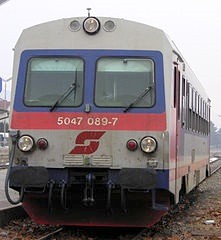 I took
the train from Vienna to Eisenstadt. It runs every hour and takes about 1¼ hours to get there. It was a fairly short walk
to the street where the Archives are located. Once I got to the address, however, I had no clue where to go—that was
another of my unanswered questions. I went into the Catholic Bookstore nearby and the lady working there said I’d never
find the place. She made a phone call and told me to walk in a certain direction and that the secretary would meet me and
take me to the Archives. I was led to a small room that was filled with church registers. Each pile had a town name
hanging from it. The secretary showed me the two piles I was interested in. They are in stacks with the current names of
the towns: Neumarkt im Tauchental and Weiden bei Rechnitz. You can take photos of the books or take notes in pencil. I was
left alone in the room with plenty of pencils, a stack of notepaper, and a list of handwriting samples from various
centuries to help me out. I was very surprised to be given this much freedom among such old records. I took
the train from Vienna to Eisenstadt. It runs every hour and takes about 1¼ hours to get there. It was a fairly short walk
to the street where the Archives are located. Once I got to the address, however, I had no clue where to go—that was
another of my unanswered questions. I went into the Catholic Bookstore nearby and the lady working there said I’d never
find the place. She made a phone call and told me to walk in a certain direction and that the secretary would meet me and
take me to the Archives. I was led to a small room that was filled with church registers. Each pile had a town name
hanging from it. The secretary showed me the two piles I was interested in. They are in stacks with the current names of
the towns: Neumarkt im Tauchental and Weiden bei Rechnitz. You can take photos of the books or take notes in pencil. I was
left alone in the room with plenty of pencils, a stack of notepaper, and a list of handwriting samples from various
centuries to help me out. I was very surprised to be given this much freedom among such old records.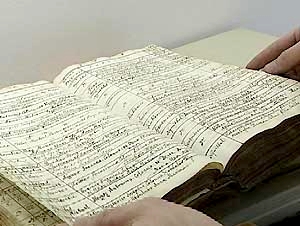 I
spent about 5 hours and barely made a dent in my search. I didn’t even look at the oldest records. They date back to the
1600’s for Neumarkt but all of the information is listed randomly in order of occurrence—births, deaths, and marriages are
all mixed together in cramped old-fashioned handwriting. With the time I had I knew this was a task for another visit.
Maiden names for the women were not listed until about 1810-15, so that made tracking people a bit more difficult. The
most interesting records were the recent ones. These went up into, I believe, the 1970’s. The records often listed not
only the name of the deceased but where the person was born, where they died, where they had lived, family members, birth
and death dates, cause of death, and sometimes there were personal comments. It was fascinating reading. I read of my
great-grandmother’s death of old age in the same house where she had spent her entire married life: Allersgraben #1. I
spent about 5 hours and barely made a dent in my search. I didn’t even look at the oldest records. They date back to the
1600’s for Neumarkt but all of the information is listed randomly in order of occurrence—births, deaths, and marriages are
all mixed together in cramped old-fashioned handwriting. With the time I had I knew this was a task for another visit.
Maiden names for the women were not listed until about 1810-15, so that made tracking people a bit more difficult. The
most interesting records were the recent ones. These went up into, I believe, the 1970’s. The records often listed not
only the name of the deceased but where the person was born, where they died, where they had lived, family members, birth
and death dates, cause of death, and sometimes there were personal comments. It was fascinating reading. I read of my
great-grandmother’s death of old age in the same house where she had spent her entire married life: Allersgraben #1.The workers at the Archives were all very friendly and spoke a bit of English. Since you’re left on your own, the lack of English speaking isn’t a real issue. Don’t expect them to do any research for you. If you have just a few facts to check out then a one-time visit might work. For what I wanted to accomplish, I suspect that I need to spend 3 or 4 full days. I had hoped to trace the Osztovics’ line back to the one or two families who came to the Burgenland from Croatia. By the late 1700’s, there were already quite a few different families in the area. Perhaps a whole crew of them came up together. The answer might lie in those old books waiting in Eisenstadt for my next, longer visit. |
3) BOOK REPORT: "BORDERLAND," BY ANDREW F BURGHARDT 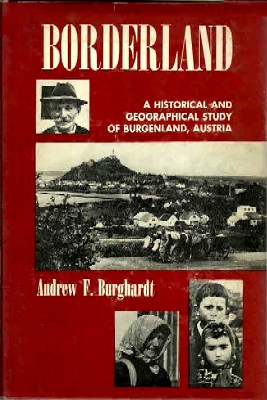 A
few months ago, while searching for something else, I found on Amazon Books a copy of Andrew F Burghardt's 1962
book, Borderland: A Historical and Geographical Study of Burgenland, Austria (University of Wisconsin Press). The
price was a remarkably low $1.98 (with shipping of $3.99). There was a second copy too... but that one was priced at
nearly $45 (plus shipping). Given the book, which is long out-of-print, seldom appears online at a moderate price, I
snatched up the $1.98 copy immediately! (As a result, the other copy has now jumped up to $98.62 and a copy appeared on
AbeBooks priced at $100, both plus shipping.) A
few months ago, while searching for something else, I found on Amazon Books a copy of Andrew F Burghardt's 1962
book, Borderland: A Historical and Geographical Study of Burgenland, Austria (University of Wisconsin Press). The
price was a remarkably low $1.98 (with shipping of $3.99). There was a second copy too... but that one was priced at
nearly $45 (plus shipping). Given the book, which is long out-of-print, seldom appears online at a moderate price, I
snatched up the $1.98 copy immediately! (As a result, the other copy has now jumped up to $98.62 and a copy appeared on
AbeBooks priced at $100, both plus shipping.)My copy arrived promptly and proved to be in great condition, though the cover and binding had been replaced by a plain but stronger "library" version. Inside, it is stamped "The Public Library of the District of Columbia, Washington, DC" and the checkout card is still in the back, so it appears I have to thank those Washingtonians who, as a group, sufficiently ignored this book to cause a librarian to discard it. In looking over our BB Newsletters, I found that Borderland had been mentioned numerous times but had never received more that a cursory, two or three sentence review, even though it was the subject of the very first (mini-) article in Edition 1 of the BB Newsletter back in January, 1997! Way back then, Gerry said: "Best general history of the Burgenland in English, but $121!" Having now completed my personal cover-to-cover read of the book, I agree with Gerry (though I find my $1.98 price much more palatable) and have decided a full review is long overdue; thus this book report. While I will give a general overview of the full book here, I will also, some day, revisit particular ideas presented in the book, as I believe they well warrant a longer exposition than I can do in this book report. The book, itself, is some 365+ pages in length, of which 284 are the text proper, 46 are endnotes, 18 are a comprehensive bibliography, and the last 16 are a detailed index. In addition, there are 8 pages in the middle of the book holding 16 photographic plates that illustrate details that are discussed in the text. There are also 10 maps within the text that are frequently referenced (because my copy was re-bound, it is missing the map of the Carpathian Basin that is supposed to be on the end papers). The "front matter" includes a 3-page Preface by the author, a Table of Contents, list of Illustrations (photographic plates), and a list of Maps. These listings and the detail level of the Index suggest it will be a great reference book. I was pleasantly surprised to discover that it was truly a "good read"—the writing style flowed, the text was full of interesting detail and facts, and the story-telling kept my interest. As the subtitle suggests (A Historical and Geographical Study of Burgenland, Austria) and, as the author says in his first Chapter,
Burghardt's major premise is that the geography of the land shaped the development and politics of Burgenland and the
surrounding region; he does a good job of supporting that view. |
4) THE WINDMILL OF PODERSDORF AM SEE (by Hannes Graf) We have been republishing some articles Hannes wrote over past years for placement on his personal site, Spirit of Gradišće - Őrvidék Group. This month, we are presenting a short article about the Windmill of Podersdorf Am See, the one surviving example of windmills that once existed and provided useful services in the Seewinkel. I supplement that article with a modern update. 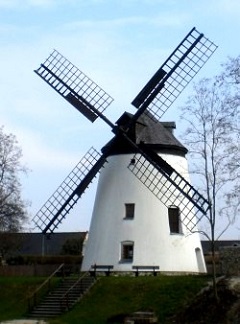 The
Windmill of Podersdorf am See (by Hannes Graf) The
Windmill of Podersdorf am See (by Hannes Graf)The town of Podersdorf am See is located in the Burgenland Seewinkel, an offshoot of the Hungarian Plain. There is no creek for the operation of water mills. Therefore, the people in this area always have been dependent on the force of the wind. For this reason, here, as in the whole Hungarian area, windmills were built. 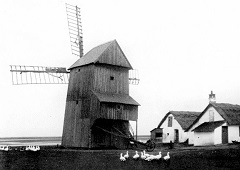 Originally,
there were seven windmills in Seewinkel, but the only still completely intact one is located in Podersdorf. The windmill
is about 160 years old. It is still privately owned by the family Lentsch. During 2001, the "Podersdorf Windmill Club" was
formed. It is committed to conservation and renovation of the windmill and to the organization of the visitor operations
that ensures and organizes activities. Originally,
there were seven windmills in Seewinkel, but the only still completely intact one is located in Podersdorf. The windmill
is about 160 years old. It is still privately owned by the family Lentsch. During 2001, the "Podersdorf Windmill Club" was
formed. It is committed to conservation and renovation of the windmill and to the organization of the visitor operations
that ensures and organizes activities.Opening times: The windmill is open daily, from the beginning of May until late October. Tours are available daily during this period until around 7:00 p.m. (see www.diewindmuehle.at). Update: Hannes' article caused me to wonder whether more information about the Podersdorf and other Burgenland windmills was available. Concerning the Podersdorf windmill, I learned the following:
While I did not find anything about other old Burgenland windmills, I came across this curious picture: |
5) FOLLOW-UP TO "MARIA HOFFMANN HOTWAGNER" In Newsletter #231 (April 30, 2013), I wrote about the sons of Maria Hotwagner, one of whom, Joseph, was accused of treason during WW-II and sentenced to 10 years in prison in a subcamp of the Dachau concentration camp, barely avoiding being executed outright. Four other prisoners were immediately, as they were convicted of a higher offense, conspiracy to commit high treason: Johann Untenecker, Johann Balaskovics, Michael Balogh and Imre Kiss. John Rajkovacz of Muskegon, WI, writes (in part): [Within that article,] my grandfather Karl Balogh's brother is identified as being executed in December of 1942 by the Nazi's. I have a picture of him and he was a decorated veteran of WW-I with the Hungarian Big Silver, probably equivalent to our Silver Star. My daughter's father-in-law, who is Hungarian, recognized it because his father also received it. My uncle Balogh told me that a number of others were also executed then, including my grandfather's brother-in-law, Stefan Arth, plus others. My mother's brother, Karl Balogh Jr., was a prisoner in Russia for almost 7 years, to about 1950. Russia had about 5,000 POW's that were released through the efforts of the German chancellor Adenauer "Der Alte". I know that Karl Jr. offered to take my mother to Graz, where the executions took place, but she refused to go to that 'place of barbarous killings'. I am a little confused because I thought the killings occurred in Dec of 1944 when the Nazi's went on a blood bath.  I
replied (in part): Hi John, I quote material from
http://www.kriegserinnerungen.at/wilhelm_gregorich.htm for the execution date. Also, you can find this image online
(at page http://www.dade.at/bildein/museum4.htm), which also appears
to confirm the 1942 date. I
replied (in part): Hi John, I quote material from
http://www.kriegserinnerungen.at/wilhelm_gregorich.htm for the execution date. Also, you can find this image online
(at page http://www.dade.at/bildein/museum4.htm), which also appears
to confirm the 1942 date.My understanding is that these four are also recognized on a 1991 monument in Rechnitz, though I do not know if the death date is included. Beyond that, it is clear that many others were executed for “treason” during the war (in fact, it was the death of earlier victims that led to these deaths), though it also appears that only these four were executed together on that day. I would not want to argue with your uncle but, is it possible that by “then” he meant “during the war”? Regardless, my sympathies to your extended family; it appears they suffered much during that time. I wish I were better able to resolve the death date issue for you; however, the above is all I know. John replies: Dear Tom, I was only nine when WW-II started so my recollection of events may be flawed. I served in the army of occupation and was permitted to enter the Russian zone and visit grandparents in Schachendorf and Grosspetersdorf. I did not discuss unpleasant events then. Most of my recall are with family who are now gone. The above shows that our Burgenland circle remains quite small: Walter Hoffman's cousin, Josef Hotwagner, and John's great uncle, Michael Balogh, were both caught up in a Nazi suppression/reprisal action during WW-II in Burgenland, and neither survived... sad. |
6) HISTORICAL BB NEWSLETTER ARTICLES Editor: This is part of our series designed to recycle interesting articles from the BB Newsletters of 10 years ago. This month, I reprint one from NL 119A (June 30, 2003). In this article, BB Founder and then Editor Gerry Berghold speaks of the decline of ethnic social organizations and how internet groups, such as the BB, fulfill a forgotten need. His words remains relevant today. THE BURGENLAND BUNCH NEWS No. 119A June 30, 2003 3. PURPOSE OF ETHNIC ORGANIZATIONS LIKE THE BURGENLAND BUNCH (BB) & THE BURGENLANDISCHE GEMEINSCHAFT (BG)? (by Gerry Berghold, with thanks to Bob Strauch and Tom Glatz) Some time ago, Bob Strauch sent me an excerpt from the Allentown Morning Call, which included a letter to the editor complaining about local ethnic organizations formed by the descendants of Pennsylvania Palatinates (commonly known as Pennsylvania Dutch). The complaints mainly concerned the fact that ethnic organizations often become merely social groups, interested only in eating, drinking and having a good time (albeit with ethnic overtures). Some also engage in worthwhile local social works, sponsor money-raising events and even commercial ventures like fairs and concerts. Although these activities have value, they do little to promote ethnic heritage or preservation of ethnic language, the prime reasons for founding the organizations in the first place. When we consider the decline of ethnic clubs, we tend to blame television, current family activities and modern life styles. One rarely hears that an even more important reason may be the lack of other than social reasons for becoming an active club member. The Internet has changed all that and we now have purely non-social ethnic organizations like the BB (although there are some gatherings of Internet groups like our own Mid-West Picnic sponsored by Hap Anderson), who are strictly devoted to preserving heritage and language. That they attract large memberships (like our own 1000+ members) is indicative that they are fulfilling other than a social need. Family history certainly adds a very strong element, which is often completely lacking among purely social groups. Language preservation, while viewed as impossible and hard work by some, is readily taken up by others, viz. the Hianzen efforts of the BG and the language queries received by the BB. We can't ignore the fact, however, that we are social animals. We require physical as well as mental interaction. A physical meeting often cements relationships which have been acquired strictly through mail, telephone or Internet communication. When I visualize the BB and BG, I see the faces and hear the voices of those whom I have personally met. The others are still a vague outline, even though we may have become kindred spirits. I have come to the conclusion late in life that the preservation of ethnic heritage and language has a significance far beyond what we may imagine. As families fragment geographically and disperse, as the older generations pass on, we may well wonder why we feel rootless and alone in a seemingly uncaring and shrinking world, increasingly populated by strangers of an ethnic heritage other than our own. Family history and the study of ethnic heritage can go a long way in supplying roots and a circle of family. This is the magic we find as members of an Internet-based BB, but it should also be assisted by social activity as provided by an organization like the BG. I strongly urge BB members to consider joining a local heritage group like the BG. If a BG group has not been formed in your vicinity, consider any Austrian, Hungarian or Croatian group or join the BG by sending annual dues of $15 to their Güssing office in order to receive their newsletter and be advised of world wide Burgenland affairs. You will be promoting your ethnic heritage as well as advancing your family history. Any BB member in the Chicago area can contact Tom Glatz; in the Lehigh Valley area, Bob Strauch. More information concerning the BG and their snail-mail address can be found by viewing their website at www.burgenlaender.com. They can also be reached via the BB homepage. |
7) ETHNIC EVENTS LEHIGH VALLEY, PA (courtesy of Bob Strauch) Saturday, July 13: Biergarten at Emmaus Community Park. Sponsored by the Lehigh Sängerbund. Entertainment by The Shoreliners and the Lancaster Liederkranz Hobbychor. Info: www.lehighsaengerbund.org Sunday, July 21: Jägermeister Day at the Coplay Sängerbund. Music by Joey & Johnny. Sunday, July 21: Reading Liederkranz Singers' Volksfest and Car Show. Music by the O'such Rhythm and Music Band. Info: www.readingliederkranz.com Sunday, July 28: 128th Anniversary Celebration at the Reading Liederkranz. Entertainment by Media Ompha, the GTV Edelweiss Schuhplattlers, and the Reading Liederkranz Singers. Info: www.readingliederkranz.com LANCASTER, PA Tuesday, July 2, 5:30 to 7:30 pm: First Tuesday Buffet (Members $10 - Guests $12). Lancaster Liederkranz. Entertainment by Carl Heidlauf. Friday, July 19: Parrot Fest. Lancaster Liederkranz ($10). Music featuring Jimmy and the Parrots, performing 7 to 11 pm. Live music begins at 5:30 pm. Lancaster Liederkranz Pavilion, 722 South Chiques Rd, Manheim, PA 17545 (Salunga Exit off Rt. 283). Food served 5 to 9 pm, bar open 5 to 11 pm. NEW BRITAIN, CT Friday, July 5, 7 pm: Heimat Abend. Austrian Donau Club, 545 Arch Street, New Britain, CT (860 223-9401). Music by Joe Rogers. Friday, July 19, 7 pm: Heurigan Abend. Austrian Donau Club. Music by Schachtelgebirger Musikanten. CHICAGO, IL, Area Saturday and Sunday, July 13 & 14: The 6th Annual Gulyas Festival at the Norridge United Hungarian Church of Christ in Norridge IL. Please see the Gulyas Festival website http://bit.ly/mm_gulyas_chicago for more information. |
8) BURGENLAND EMIGRANT OBITUARIES (courtesy of Bob Strauch) John Rauchwarter  With deep
sadness, we announce the passing of John "Hans" Rauchwarter of Edmonton, Canada on May 30, 2013. With deep
sadness, we announce the passing of John "Hans" Rauchwarter of Edmonton, Canada on May 30, 2013.He was the husband of the late Ernestine (Thier) Rauchwarter. Hans was born on August 17, 1934 in Illmitz, Burgenland, Austria. He immigrated to Canada in 1959 with his wife and two children, settling in Edmonton. Opa was a sausage maker by trade and with his Liebling Erna owned and operated Jasper Meats. Even after retirement, he continued to make his delicious sausages. In his spare time he enjoyed gardening and was an avid stamp collector. Left to mourn, his children, Linda Huff and Hans (Terry) Rauchwarter. He was also a loving Opa to Shawn (Erin) Huff and Jessica, Jon and Ashley Rauchwarter; Uhropa to Kash and Cruz Huff and Opapa to Angelo Viola (Rauchwarter). He is also survived by numerous relatives in Austria. Even though it broke our hearts to lose him, we are comforted by the knowledge that he is once again in the arms of his one and only true love, Erna. A private family service has been held and cremation has taken place. Rose Peace  Rose T.
Peace, 89, a Hyde Park resident since 1985, died on Monday, June 3, 2013, at Livingston Hills Nursing Home in Livingston,
New York. Rose T.
Peace, 89, a Hyde Park resident since 1985, died on Monday, June 3, 2013, at Livingston Hills Nursing Home in Livingston,
New York.Born on January 24, 1924 in Tschanigraben, Burgenland, Austria, she was the daughter of the late Frank and Hermina (Köppel) Schadl. Rose was educated in New York City Schools and was employed by Alexander's Dept. Store in Queens for many years. She enjoyed gardening, and spending time with her family. On August 28, 1943 in Immaculate Conception Church, Bronx, NY she married Marshall Dale Peace. Mr. Peace predeceased her on January 6, 2005. She is survived by her son, Kenneth Peace and his wife, Sheila, of New Jersey; seven grandchildren, Matthew Peace and wife, Alicia, of Hyde Park, Jennifer Gamble and husband, Glenn, of New Jersey, Mark Embree of Florida, Keith Embree and wife, Amanda, of Huntington Beach, CA, Bridgette Embree of Germany, and Tara and Alana Peace, both of New Jersey; five great grand children, Kyle and Dale Peace of Hyde Park, Myckala and Katelynn Embree of Pine Plains, and Nicholas Gamble of New Jersey; great-great grandson, Bentley Michael Peace of Hyde Park; brother, Joseph Schadl of the Bronx; and several cousins in Pennsylvania. In addition to her husband and parents, she was predeceased by her daughter, Lillian Embree; and sister, Frieda Gildwell, both in 2005. Calling hours will be from 2 to 4 and 7 to 9 pm on Friday, June 7th at Sweet's Funeral Home, Inc., Route 9, Hyde Park. A Mass of Christian Burial will be celebrated by Rev. James A. Garisto at 10 am, Saturday, June 8th at Our Lady of the Rosary Chapel of St. Peter's Parish, 299 Hudson View Dr., Poughkeepsie, NY 12601. Entombment will follow in Our Lady of the Holy Souls Mausoleum, St. Peter's Cemetery, Poughkeepsie. Memorial contributions may be sent to Disabled American Veterans, Attention: GIFT PROCESSING, PO Box 14301, Cincinnati, OH 45250-0301 (www.dav.org). To send a condolence or for directions, please visit www.sweetsfuneralhome.com. Published in the Poughkeepsie Journal on June 5, 2013. Agnes Kositz  Agnes A.
Kositz, 88, of Nazareth, Pennsylvania, died June 4, 2013 in her home. She was the wife of the late John "Moatz" Kositz who
died August 26, 2011. Agnes A.
Kositz, 88, of Nazareth, Pennsylvania, died June 4, 2013 in her home. She was the wife of the late John "Moatz" Kositz who
died August 26, 2011.Born in Northampton, Pennsylvania and raised in Sulz, Burgenland, Austria, she was a daughter of the late Karl and Ida (Dragovits) Frisch. She was a sewing machine operator at the former Lehigh Frocks, Nazareth. Agnes was a member of Holy Family Catholic Church and the Altar and Rosary Society, Nazareth. She was a member of the ILGWU. Survivors: Agnes is survived by two daughters, Denise Repsher and her husband Daniel and Estelle Gimbar and her husband George, all of Nazareth. Four grandchildren, Daniel Repsher and wife Emily, Adrienne Kashner and husband Justin, Matthew Gimbar and wife Renee, and Douglas Gimbar and Fiance, Megan Mesgleski. Brother, Frank Frisch and wife Tessie, Clifton, NJ. Pre-deceased brothers, Josef and Carl Frisch. Services: Monday at 10:30 a.m. in Reichel Funeral Home 220 Washington Park, Nazareth, followed by a Mass of Christian Burial at 11 a.m. in Holy Family Church, Nazareth. Burial in Holy Family Cemetery. Calling Hours are Monday 8:30 to 10:30 a.m. in the funeral home. Contributions: In lieu of flowers, donations can be made to Holy Family Church in c/o Reichel Funeral Home, Nazareth. Published in Morning Call on June 6, 2013. Karl Zankl  It is
with profound sadness that we announce the passing of our beloved husband, dad, and "Opa" Karl, on Tuesday, June 4, 2013
at the Regina General Hospital with his family at his side. It is
with profound sadness that we announce the passing of our beloved husband, dad, and "Opa" Karl, on Tuesday, June 4, 2013
at the Regina General Hospital with his family at his side.Karl was born in Grafenschachen, Austria in 1936. He immigrated to Canada in 1956 settling in Regina, Saskatchewan. He started work for Wappell Construction as a mason when he arrived. He met his wife Anny at the Wascana Park gazebo and they were married October 11, 1958 and were happily married for 54 years. Karl later became a journeyman painter working on his own, and with other partners. In addition to his painting career, he worked in numerous roles at IPSCO for 22 years. Karl was a proud Austrian, and was a founding member of the Austrian Canadian Edelweiss Club of Regina where he served two terms as president and continued to be an active member. He was an avid hunter when he was young and a continuing active member of the Austrian Hunting and Fishing Club, often winning shooting competitions. He loved life in Regina and his "district" of Glen Elm. He was extremely proud of his children and being "Opa" to his grandchildren. He loved the quiet life at their cottage at B-Say-Tah Beach, telling stories and sharing good cheer. He was most happy when he was surrounded by all of his family and friends, with him always winning at games of horse shoes and Austrian schnapps cards. Karl is survived by his wife, Anny Zankl of 54 years; son Michael (Cheryl) Zankl; son Gary (Karla) Zankl and their children Karter, Tegan, Ashton; daughter Diane (Troy) Randall; sister, Hilda (Hans) Kremnitzer, as well as numerous relatives and friends in Canada and Austria. He is predeceased by his brother Willhelm (wife Frieda) Zankl. A Memorial Mass will be held Monday, June 10, 2013 at 10:30 a.m. at Holy Child R.C. Parish, 2636 7th Ave. E., Regina, SK with Fr. Danilo Rafael as Celebrant. Karl's family would like to express their sincere thanks to all of the staff at RGH for their kindness and support. In lieu of flowers, donations in Karl's memory may be made to the Heart and Stroke Foundation of Saskatchewan at 279 3rd Ave. N., Saskatoon, SK, S7K 2H8, or phone 1-888-473-4636. Published in The Regina Leader-Post on June 7, 2013. Willibald Maier  Willibald
"Willi" Maier, 87, passed away Saturday, June 8, 2013, at Barn Hill Care Center in Newton, New Jersey, where he was well
known and loved by his fellow residents and wonderful caretakers. Willibald
"Willi" Maier, 87, passed away Saturday, June 8, 2013, at Barn Hill Care Center in Newton, New Jersey, where he was well
known and loved by his fellow residents and wonderful caretakers.Born in Wallendorf, Austria, to Adolf and Gisella (Weber) Maier, he came to the United States when he was 21 years old. He had lived in Paterson, then the Bloomfield and Nutley areas before moving to East Stroudsburg, PA., 20 years ago. While living in Europe, Mr. Maier was involved in the welding trade and he continued to work in the same field at Upright Scaffolds in Teterboro, where he also was a manager. Mr. Maier was a member of the Coplay Sängerbund Club and was a member of the Music Makers Choir in East Stroudsburg. He loved polka music and he enjoyed dancing to the music and playing his accordion. Mr. Maier was predeceased by his wife of 59 years, Elizabeth, on Nov. 10, 2011; his son, Paul W. Maier, in 1976; his three brothers, Richard Maier, Oswald Maier and Ernest Maier; and his sister, Freda. He is survived by his daughter, Sandee VanDerWende and her husband, Craig, of Wantage; his sister, Hermine Maxey, of California; his grandchildren, Jason VanDerWende and his wife, Jennifer, and Amanda Krok and her husband, John; his great-grandchildren, Ryder VanDerWende, Madison Krok, and a great-granddaughter that is soon to be expected; and many loving nieces and nephews. Funeral services will be held at 10 a.m. Tuesday, June 11, at Pinkel Funeral Home, 31 Bank St. (Route 23), Sussex. Friends may pay their respects to the family from 2 to 4 and 7 to 9 p.m. Monday, June 10. Online condolences may be offered to the family on www.pinkelfuneralhome.com. Published in The New Jersey Herald on June 10, 2013 Rudolf Schummel  Rudolf
Schummel, 86, of Hamilton, New Jersey, passed away peacefully on Thursday, June 6, 2013, at home. Rudolf
Schummel, 86, of Hamilton, New Jersey, passed away peacefully on Thursday, June 6, 2013, at home.He was the husband of the late Sadie (Crusade) Schummel. Born in Sopron, Hungary, Mr. Schummel was the son of the late Anton and Hermine (Lagler) Schummel. He was a machinist and was retired from Goodall Rubber Co. of Hamilton after 36 years of service. He was a U.S. Army veteran of the Korean War and a faithful member of St. George Greek Orthodox Church, Hamilton. He held a private pilot's license and was a member of the West Windsor Flying Club and the Academy of Model Aeronautics, and was a member of the Hamiltonian seniors group. He is survived by his son and daughter-in-law, Anthony and Debbie Schummel, of Wallkill, NY; his daughter and son-in-law, Linda and Anthony Barbieri, of Southampton; his granddaughter, Tara Bello and her husband, Greg; his grandson, Sean Seiler; his great-grandchildren, Jesse and Gianna Bello; his sister-in-law, his brother-in-law, and his nieces and nephews. He was predeceased by his brother and sister. The funeral service will be Thursday at 12 noon from Kingston & Kemp Funeral Home, 260 White Horse Ave., Hamilton (www.KingstonandKemp.co). The Funeral Mass will be celebrated at 1 p.m. at St. George Greek Orthodox Church, 1200 Klockner Rd., Hamilton. Interment will follow at Greenwood Cemetery, Hamilton. Relatives and friends may call on Thursday from 10 a.m. to 12 noon at the funeral home. In lieu of flowers, memorial contributions may be made in Rudolf's honor to a charity of the donor's choice. Published in The Times, Trenton, on June 11, 2013 Joseph Unger  Joseph
Unger, 90, of Allentown, Pennsylvania, died June 10, 2013. Joseph
Unger, 90, of Allentown, Pennsylvania, died June 10, 2013.He was married to the late Hilda (Nickles) for 25 years. Born in Kukmirn, Burgenland, Austria on July 6, 1922, he was the son of the late Frank and Cecilia (Muhr) Unger. Joseph served in the U.S. Marines in WW-II, where he was saw active duty in the Pacific Theatre as a rifle marksman on Guadalcanal in the Solomon Islands and Iwo Jima. He was wounded in action twice, receiving the Purple Heart and Bronze Star. Joseph was a lifetime member of The Military Order of the Purple Heart. After serving in the military he was employed at Brey and Krause Manufacturing Co, where he was the plant manager of metal finishing for 45 years. He also worked at Spandex USA inc. as a second career. Joseph was a devoted member of Faith Evangelical Free Church. Survivors: daughter, JoAnn (Unger) Jones, married to the late John A. Jones; and their son, Spencer J. A. Jones. In addition he is survived by a step son, two step daughters, and their families. He was preceded in death by siblings: Margaret Koether, Julius Unger, Alvin Unger, Emma Hoanzle, Frank Unger, Rudolph Unger, and a sister, who died in her youth. Services: Graveside services will be held at 10 a.m., at Highland Park Cemetery on Roth Ave., Allentown on Saturday, June 15, 2013. Contributions: In lieu of flowers, memorial contributions may be made to the Faith Evangelical Free Church of 6528 Hamilton Blvd., Allentown. Published in Morning Call on June 13, 2013 |
END OF NEWSLETTER |
NOTICE (Terms and Conditions): The Burgenland Bunch (BB) was formed and exists to assist Burgenland descendants in their research into their heritage and, toward that end, reserves the right to use any communication you have with us (email, letter, phone conversation, etc.) as part of our information exchange and educational research efforts. • If you do not want your communication to be used for this purpose, indicate that it is "confidential" and we will abide by that request. • Correspondents who communicate with the BB without requesting confidentiality retain their copyright but give a non-exclusive license to the BB allowing us to forward to BB members, publish in our monthly newsletter or on our website, and/or subsequently and permanently archive all or parts of such communications. The Burgenland Bunch homepage (website) can be found at: http://www.the-burgenland-bunch.org/ Burgenland Bunch Newsletter, copyright © 2013 by The Burgenland Bunch All rights reserved. Permission to copy excerpts granted if credit is provided. |
 News
News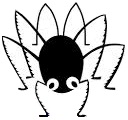 The
BB website walks a careful line between sharing information (which is our purpose) and defeating web-harvesting spiders.
There is actually some anti-robot coding in use, so what is in the underlying page code (which is what a robot reads) is
not the same as what you see (specifically, email address are not in the underlying code in the form of a standard
address, so robots do not see them). We implemented that system seven years ago and complaints/concerns by members have
essentially disappeared. Before that, rightly or wrongly, we did receive complaints.
The
BB website walks a careful line between sharing information (which is our purpose) and defeating web-harvesting spiders.
There is actually some anti-robot coding in use, so what is in the underlying page code (which is what a robot reads) is
not the same as what you see (specifically, email address are not in the underlying code in the form of a standard
address, so robots do not see them). We implemented that system seven years ago and complaints/concerns by members have
essentially disappeared. Before that, rightly or wrongly, we did receive complaints.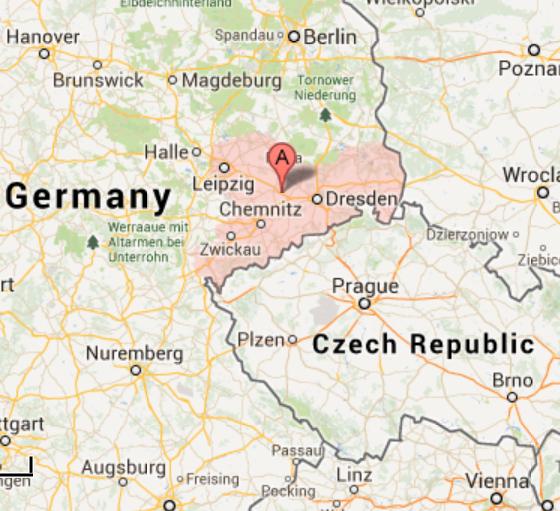 This
Burgenland—unlike our Burgenland—is so-named because of the
many castles in the area (one of its advertising slogans is that "a detour here is to visit the Middle Ages"); its name is
not an official governmental-unit designation of any kind (although there is a Burgenland Kreis (District) in the
neighboring German state). Both this Burgenland and its neighboring Heideland are found in the center of the German state
of Saxony, beside Poland and above the Czech Republic, and between Leipzig and Dresden (marked 'A' in the map to the
right). It generally follows the Mulde and Zschopau River valleys, with Romanesque castles perched on cliffs
or on the densely wooded hillsides above the rivers.
This
Burgenland—unlike our Burgenland—is so-named because of the
many castles in the area (one of its advertising slogans is that "a detour here is to visit the Middle Ages"); its name is
not an official governmental-unit designation of any kind (although there is a Burgenland Kreis (District) in the
neighboring German state). Both this Burgenland and its neighboring Heideland are found in the center of the German state
of Saxony, beside Poland and above the Czech Republic, and between Leipzig and Dresden (marked 'A' in the map to the
right). It generally follows the Mulde and Zschopau River valleys, with Romanesque castles perched on cliffs
or on the densely wooded hillsides above the rivers. Liederkranz
Cheese (aged 1+ months) - 6 oz
Liederkranz
Cheese (aged 1+ months) - 6 oz The
Smithsonian Folklife Festival (Second Notice): The Smithsonian Folklife Festival, is underway, being held Wed-Sun,
June 26-30 and July 3-7. If you could not make it to the first week's activities, you may wish to stop by during the
second week, as the Festival has special interest to Burgenländers this year.
The
Smithsonian Folklife Festival (Second Notice): The Smithsonian Folklife Festival, is underway, being held Wed-Sun,
June 26-30 and July 3-7. If you could not make it to the first week's activities, you may wish to stop by during the
second week, as the Festival has special interest to Burgenländers this year. Heritage:
Roots to Revival, a program that "highlights the vitality of Hungary’s cultural heritage in music, costume,
crafts, games, food, wine, and dance—including the 'dance hall movement,' the grassroots revival of village dance
traditions in urban settings." More info about this program is at
Heritage:
Roots to Revival, a program that "highlights the vitality of Hungary’s cultural heritage in music, costume,
crafts, games, food, wine, and dance—including the 'dance hall movement,' the grassroots revival of village dance
traditions in urban settings." More info about this program is at
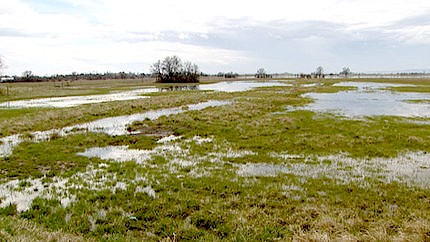 Due
to the heavy precipitation of last winter, coupled with spring rains, the Seewinkel region in Burgenland has standing
water in many meadows and fields. The article calls this a "spectacle of nature" and a
"flashback to a long forgotten time."
Due
to the heavy precipitation of last winter, coupled with spring rains, the Seewinkel region in Burgenland has standing
water in many meadows and fields. The article calls this a "spectacle of nature" and a
"flashback to a long forgotten time." 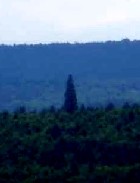
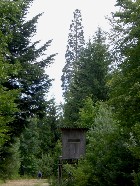
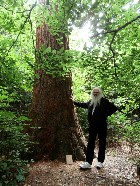
 2
young chickens (2½ lb. each) 1/4 tsp. salt
2
young chickens (2½ lb. each) 1/4 tsp. salt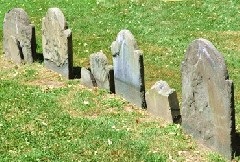 Izzy
the Atheist, a friend of Doc Delaney, consoles Doc on the finally-confirmed death of his wife, who had disappeared nearly
a year before:
Izzy
the Atheist, a friend of Doc Delaney, consoles Doc on the finally-confirmed death of his wife, who had disappeared nearly
a year before: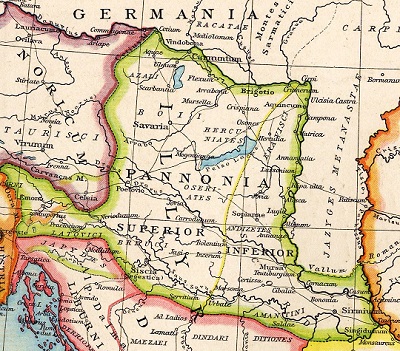 This
first section is titled by the name the Romans gave to their part of the basin (the part southwest of the
Danube river): Pannonia. Burghardt argues that the flat, dry, treeless nature of the plains and steppe that
make up the floor of the elliptical basin formed by the Alps, Carpathians and the Balkan highlands is the key feature
explaining the development and politics of Burgenland and the larger Basin. Simply put, the basin provided poor defensive
features and little water for settled people, thus it was constantly subjected to intermittent raids by horseback-riding,
nomadic tribes. The only reasonable line of defense was the Danube River, which was more formidable back then due to the
wide swamps that bordered the river (now drained, of course). Thus the Romans placed their "limes" [from Latin, meaning
"a fortified boundary or border"] at the river, leaving the open steppe to the north and east of the river to the
marauders.
This
first section is titled by the name the Romans gave to their part of the basin (the part southwest of the
Danube river): Pannonia. Burghardt argues that the flat, dry, treeless nature of the plains and steppe that
make up the floor of the elliptical basin formed by the Alps, Carpathians and the Balkan highlands is the key feature
explaining the development and politics of Burgenland and the larger Basin. Simply put, the basin provided poor defensive
features and little water for settled people, thus it was constantly subjected to intermittent raids by horseback-riding,
nomadic tribes. The only reasonable line of defense was the Danube River, which was more formidable back then due to the
wide swamps that bordered the river (now drained, of course). Thus the Romans placed their "limes" [from Latin, meaning
"a fortified boundary or border"] at the river, leaving the open steppe to the north and east of the river to the
marauders.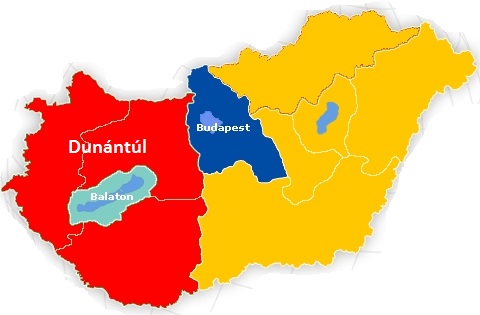 He
now moves to his second section: Dunántúl, the Hungarian name for the most of the lands once
known as Pannonia. This covers the 1000 years that the Hungarians held the lands now known as Burgenland, beginning with
the Magyar defeat by Otto I the Great, King of the Germans, in the 955 Battle of Lechfeld (near Augsburg,
Germany), which ended the Magyar forays into Western Europe. Thereafter, the Magyars were content to stay in the
Carpathian basin and begin their transformation from a loose confederation of tribes to an organized state. St. Stephen,
and his official recognition by the Church and the western European states, was key in this transformation.
He
now moves to his second section: Dunántúl, the Hungarian name for the most of the lands once
known as Pannonia. This covers the 1000 years that the Hungarians held the lands now known as Burgenland, beginning with
the Magyar defeat by Otto I the Great, King of the Germans, in the 955 Battle of Lechfeld (near Augsburg,
Germany), which ended the Magyar forays into Western Europe. Thereafter, the Magyars were content to stay in the
Carpathian basin and begin their transformation from a loose confederation of tribes to an organized state. St. Stephen,
and his official recognition by the Church and the western European states, was key in this transformation.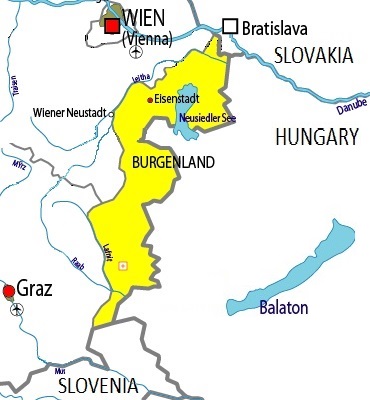 He
now narrows his focus in the third section: Burgenland. Burghardt starts with the details of the transfer
from Hungary to Austria, discussing the political motivations of all the countries involved in the process, then detailing
the establishment of the eastern border, both how it was established and the political, social and economic effects of the
chosen boundary line. We have talked about these issues before... but Burghardt does it with a depth and sensitivity that
make the topics well worth reviewing again.
He
now narrows his focus in the third section: Burgenland. Burghardt starts with the details of the transfer
from Hungary to Austria, discussing the political motivations of all the countries involved in the process, then detailing
the establishment of the eastern border, both how it was established and the political, social and economic effects of the
chosen boundary line. We have talked about these issues before... but Burghardt does it with a depth and sensitivity that
make the topics well worth reviewing again.
